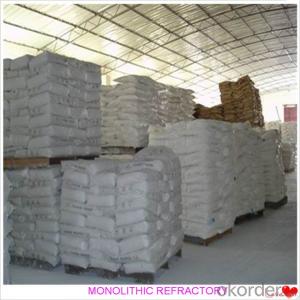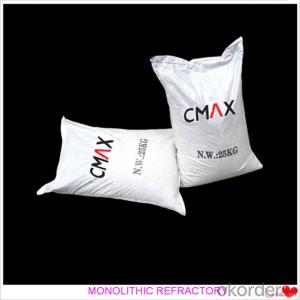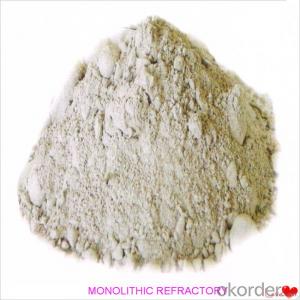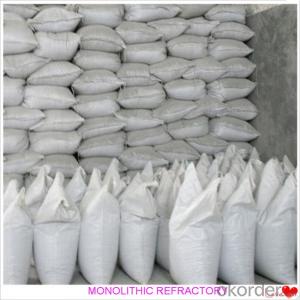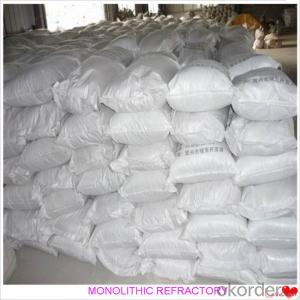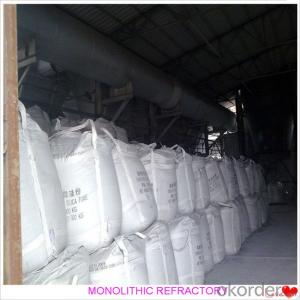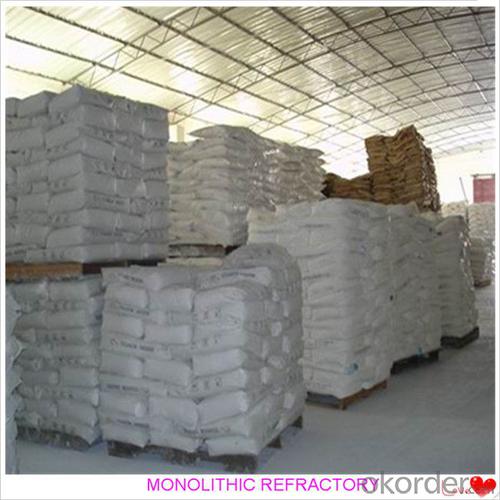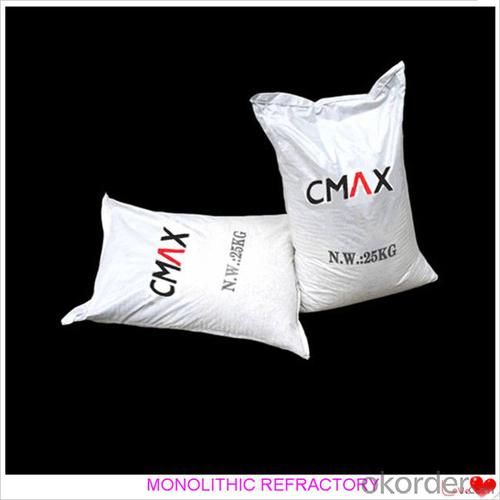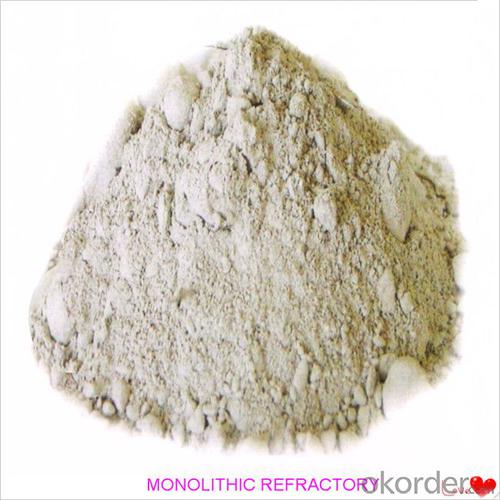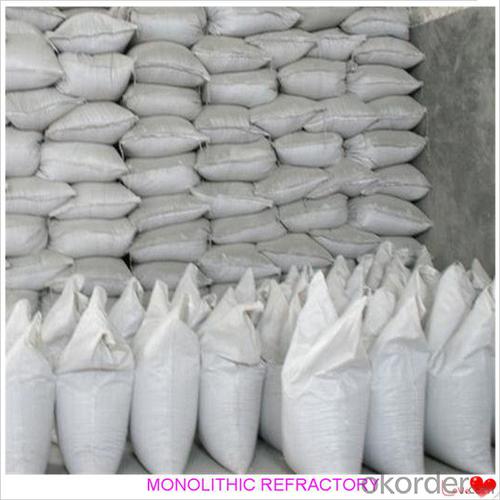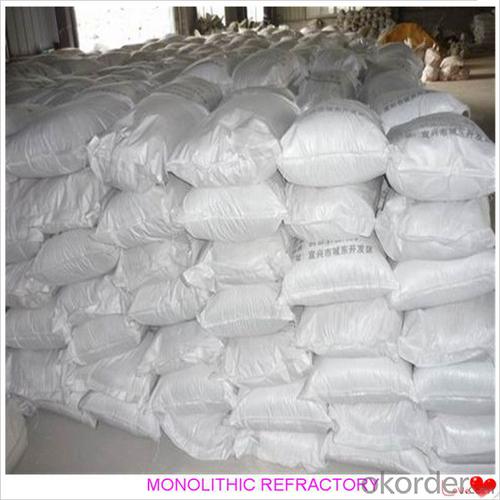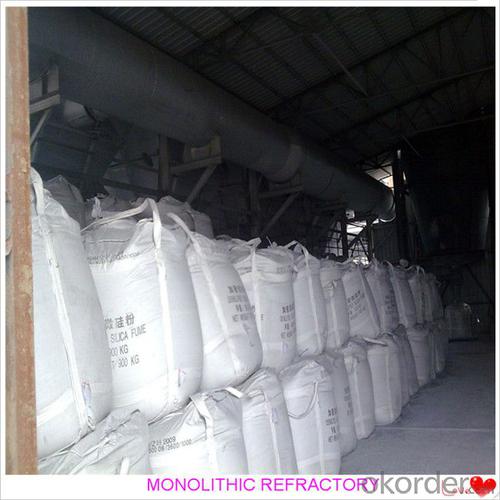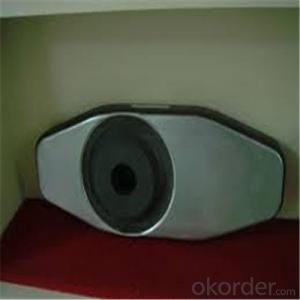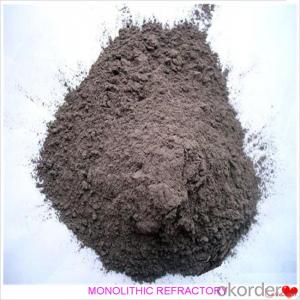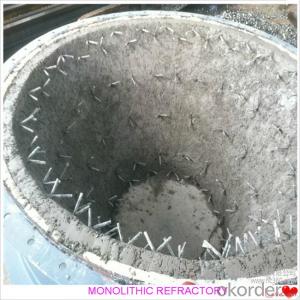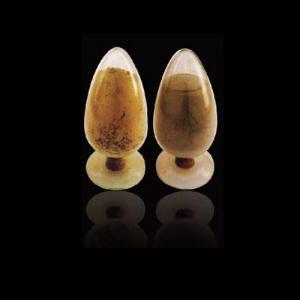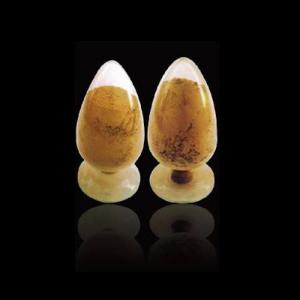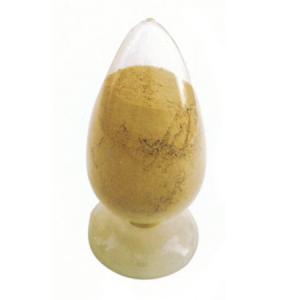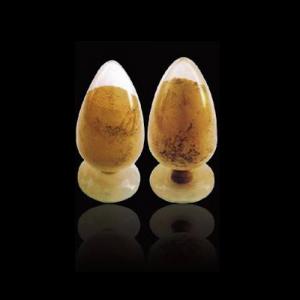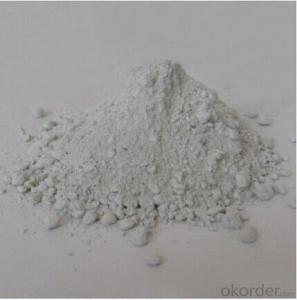Monolithic Refractories for Iron and Steel Industry - High Alumina Castable for Fireside and Industrial Furnace
- Loading Port:
- China main port
- Payment Terms:
- TT OR LC
- Min Order Qty:
- 1000 kg
- Supply Capability:
- 3000000 kg/month
OKorder Service Pledge
OKorder Financial Service
You Might Also Like
High Alumina Castable For Fireplace and Industrial Furnace in Iron and Steel
Product Description:
High alumina castable is manufactured according to international standards. The product is famous for its excellent abrasion resistance and low thermal conductivity. Further, these can be provided in different specifications as required by the clients. The High alumina castables are used high purity raw materials and additives as the main material, and made of under superfine powder adding technology.
Product Advantages:
The material has excellent structural stability and air tightness, and has high physical and chemical properties, also has a fine working ability.They should be used with the same material products.
Product Applications:
For feature of High alumina castable, they have excellent abrasion resistance, thermal shock resistance, high-temperature resistance, anti-corrode and have high intensity.
Designed for refractory lining of blast furnace iron and slag runners, skimmers and soon
They can be used in troughs of small and mid size BFs and in all positions of the troughs where fast tapping is required.
Product Specifications:
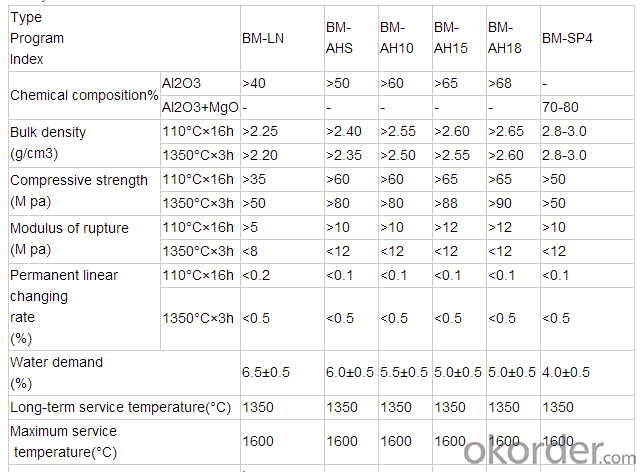
FAQ:
1. How you can control your quality?
For each production processing, we have complete QC system for the chemical composition
and Physical properties. After production, all the goods will be tested, and the quality certificate
will be shipped along with goods.
2. What's your delivery time?
It usually needs about 20days- 45 days after receiving the deposit.
3. Do you provide free samples?
Yes, we can provide a free sample for testing, If we have sample in stock,
The quantity based on the material type, The buyer should bear all the shipping costs.
4. What's your payment terms?
We can accept 30% deposit, 70% balance before shipment for ordrs over $ 2000.
5. Can we visit your Company?
Yes, certainly. You are very welcome to China and we will be honored to have a customer and friend.
Product Picture:
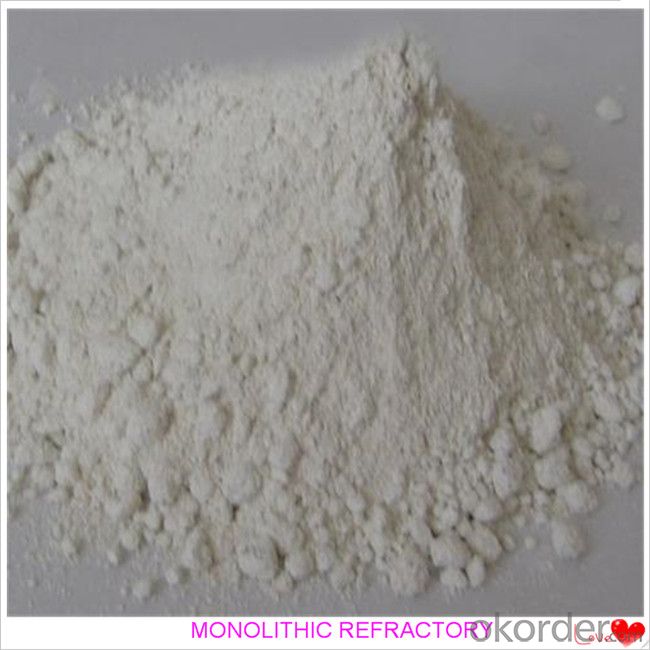
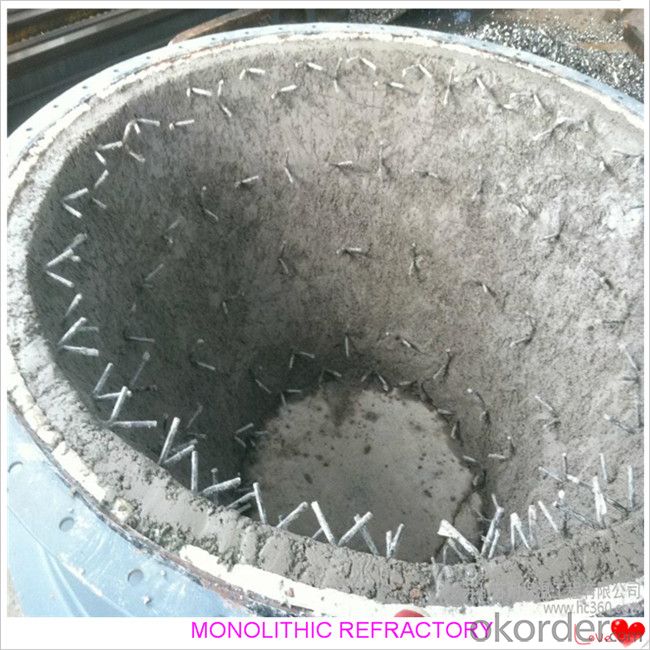
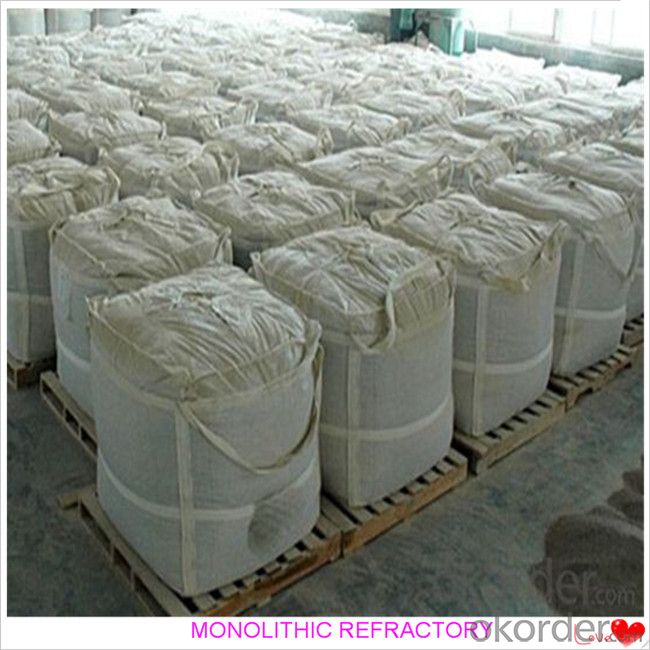
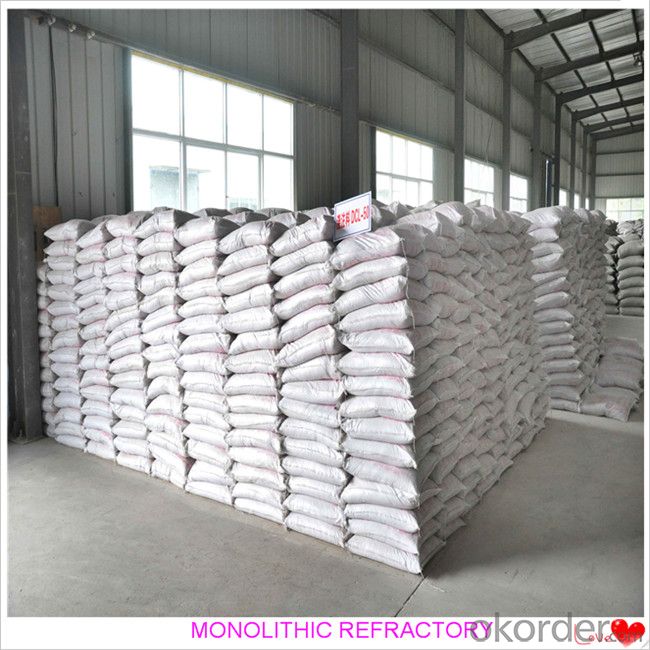
- Q: How do monolithic refractories withstand the corrosive environments in steelmaking processes?
- Monolithic refractories are able to withstand corrosive environments in steelmaking processes due to their unique properties and composition. First and foremost, monolithic refractories are known for their high resistance to temperature and thermal shock. Steelmaking processes involve extremely high temperatures, sometimes reaching up to 1700 degrees Celsius. Monolithic refractories are designed to withstand these extreme temperatures without losing their structural integrity. Additionally, monolithic refractories have excellent chemical resistance. The corrosive environments in steelmaking processes often consist of aggressive chemicals such as molten metal, slag, and gases like carbon monoxide and sulfur dioxide. Monolithic refractories are made from materials that are resistant to these chemicals, preventing them from reacting and causing corrosion. Moreover, monolithic refractories have a dense and homogeneous structure. This helps to prevent the penetration of corrosive agents into the refractory material, further enhancing its resistance to corrosion. The dense structure also minimizes the formation of cracks and fissures, which can act as pathways for corrosive agents to infiltrate the refractory. Furthermore, monolithic refractories are often made from materials with high refractoriness, such as alumina, magnesia, and silica. These materials have high melting points, which makes them more resistant to the extreme temperatures in steelmaking processes. They also have low thermal conductivity, which helps to minimize heat transfer and reduce the risk of thermal damage to the refractory. Lastly, monolithic refractories are often designed with specific additives and binders that enhance their resistance to corrosion. These additives can include materials like zircon, chrome, or graphite, which provide additional protection against the corrosive environment. In conclusion, monolithic refractories withstand the corrosive environments in steelmaking processes through their high resistance to temperature and thermal shock, excellent chemical resistance, dense and homogeneous structure, high refractoriness, and the use of specific additives and binders. These properties and characteristics make monolithic refractories an ideal choice for withstanding the harsh conditions of steelmaking processes and ensuring the longevity and efficiency of the refractory lining.
- Q: What are the challenges faced in the application of monolithic refractories?
- There are several challenges faced in the application of monolithic refractories. Firstly, one of the major challenges is the proper installation of monolithic refractories. Unlike traditional brick refractories that can be easily laid and stacked, monolithic refractories require specialized skills and techniques for proper application. The consistency and workability of the refractory material must be carefully controlled, and the installation process often requires the use of specialized equipment such as gunning machines or vibrating tools. Another challenge is the selection of the appropriate monolithic refractory material for a specific application. There are various types of monolithic refractories available, each with its own unique properties and suitability for different environments. Choosing the wrong type of refractory material can result in premature failure and costly repairs. Therefore, it is essential to understand the operating conditions, such as temperature, chemical exposure, and mechanical stress, to select the most suitable monolithic refractory material. Additionally, monolithic refractories are susceptible to thermal shock and erosion due to their composition and application method. They are typically made from fine powders that are mixed with water or other binding agents to form a paste. This paste is then applied and dried to form a solid refractory lining. However, during the heating and cooling cycles, monolithic refractories can experience thermal expansion and contraction, leading to cracking and spalling. Moreover, the chemical reactions occurring in some industrial processes can cause chemical attack and erosion of the refractory lining, reducing its lifespan. Furthermore, maintenance and repair of monolithic refractories can also be challenging. Unlike brick refractories that can be easily replaced, repairing monolithic refractories often requires skilled personnel and specialized techniques. The damaged area needs to be removed, and a new layer of refractory material must be applied, ensuring proper bonding and compatibility with the existing lining. This process can be time-consuming and costly, particularly in high-temperature applications where extended downtime can result in significant production losses. In summary, the challenges faced in the application of monolithic refractories include proper installation techniques, selection of the appropriate material, susceptibility to thermal shock and erosion, and complex maintenance and repair procedures. Overcoming these challenges requires expertise, careful planning, and a thorough understanding of the specific operating conditions and requirements for each application.
- Q: How do monolithic refractories impact the quality and performance of iron and steel products?
- The quality and performance of iron and steel products rely heavily on monolithic refractories. These refractories are designed to withstand extreme temperatures and harsh conditions, making them indispensable in the iron and steel industry. To begin with, monolithic refractories contribute to the overall quality of iron and steel products by providing exceptional thermal insulation. They help maintain a consistent and controlled temperature during the manufacturing process, which is especially crucial in blast furnaces where temperatures can reach up to 2,000 degrees Celsius. By effectively insulating the furnace walls, monolithic refractories minimize heat loss and ensure efficient energy utilization. As a result, the products have higher quality and improved mechanical properties. Additionally, monolithic refractories offer superior resistance to chemical and physical wear. In the steelmaking process, the molten metal and slag can be highly corrosive, leading to erosion and deterioration of the refractory lining. However, monolithic refractories are engineered to withstand such aggressive environments, providing excellent resistance to chemical attack and mechanical stress. By preserving the integrity of the lining, they prevent contamination and extend the lifespan of the furnace or ladle, ultimately enhancing the quality of the final iron and steel products. Moreover, monolithic refractories allow for greater design flexibility and ease of installation. Unlike traditional refractory bricks that require precise placement and fitting, monolithic refractories can be applied as a single, cohesive material. This enables the creation of more intricate shapes and structures, optimizing furnace design and enhancing thermal efficiency. Additionally, the ease of installation reduces downtime during maintenance and repairs, ensuring uninterrupted production and minimizing disruptions to the manufacturing process. In conclusion, monolithic refractories have a significant impact on the quality and performance of iron and steel products. They provide exceptional thermal insulation, resist chemical and physical wear, and offer greater design flexibility. By maintaining consistent temperature environments, preventing contamination, and enabling efficient production processes, monolithic refractories contribute to the production of high-quality iron and steel products that meet the rigorous demands of various industries.
- Q: How do monolithic refractories prevent heat loss through convection?
- Monolithic refractories effectively prevent heat loss through convection due to their unique composition and structure. Unlike traditional refractory bricks, which often have gaps and are porous, monolithic refractories are made of a single, seamless structure. This eliminates any possible pathways for hot gases or air to circulate and carry away heat by convection. Furthermore, monolithic refractories have a high thermal conductivity and are often dense, making them excellent conductors of heat. This allows them to rapidly absorb and distribute heat, minimizing the temperature difference between the hot surface and the surrounding environment. By reducing the temperature gradient, monolithic refractories decrease the driving force for convection, resulting in reduced heat loss through this mechanism. Moreover, monolithic refractories can be applied as a continuous lining, conforming to the shape of the equipment or furnace being protected. This seamless application eliminates joints or gaps where hot gases or air could escape and carry away heat. The uniform and uninterrupted lining further decreases the potential for convection heat loss. In summary, monolithic refractories are specifically designed to create a barrier that hinders the movement of hot gases or air, effectively minimizing heat loss through convection. Their dense composition, high thermal conductivity, and seamless application all contribute to their effectiveness in preventing heat loss through this mechanism.
- Q: How do monolithic refractories perform in rotary kiln applications?
- Monolithic refractories perform exceptionally well in rotary kiln applications due to their high thermal shock resistance, excellent chemical resistance, and superior strength at high temperatures. Their ability to withstand extreme heat and harsh chemical environments makes them ideal for lining the interior of rotary kilns. Additionally, monolithic refractories offer easy installation and maintenance, ensuring efficient and reliable kiln operations.
- Q: How do monolithic refractories contribute to the overall efficiency of steel ladle operations?
- Monolithic refractories play a crucial role in enhancing the overall efficiency of steel ladle operations. They provide a protective lining that withstands extreme temperatures, chemical reactions, and mechanical stresses during the steelmaking process. This lining helps to retain heat and prevent heat loss, ensuring better temperature control and reducing energy consumption. Additionally, monolithic refractories minimize metal penetration and slag adhesion, improving ladle cleanliness and reducing the risk of clogging or blockages. Overall, the use of monolithic refractories in steel ladles promotes higher productivity, improved steel quality, and cost-effective operations.
- Q: How are monolithic refractories used in the iron and steel industry?
- Due to their exceptional performance and versatility, monolithic refractories are widely utilized in various applications within the iron and steel industry. Composed of a uniform material, these refractories serve as seamless linings in high-temperature environments. In the iron and steel industry, the significance of monolithic refractories cannot be overstated as they play a crucial role in multiple stages of the manufacturing process. A primary application is seen in the blast furnace, where the inside of the furnace is lined with monolithic refractories. This lining is exposed to exceedingly high temperatures and harsh chemical reactions. By providing excellent thermal insulation and resistance to chemical attack, monolithic refractories ensure the durability and longevity of the blast furnace. Another crucial application is witnessed in the steelmaking process, where monolithic refractories are used to line the ladles and tundish, utilized for transporting and pouring molten steel. These refractories are specially designed to withstand the corrosive nature and high temperatures of the molten steel, thus preventing contamination and guaranteeing the quality of the final product. Furthermore, monolithic refractories find application in various ancillary equipment and structures within the iron and steel industry. They are employed in furnaces, kilns, and other heat treatment systems to provide insulation and maintain high-temperature conditions. Additionally, they are used in the construction of chimneys, exhaust ducts, and other exhaust systems, where they offer thermal insulation and resistance against corrosive gases. Overall, the vital role played by monolithic refractories in the iron and steel industry lies in their ability to provide high-temperature insulation, chemical resistance, and durability. They optimize the production process, enhance energy efficiency, and ensure the quality of the final product. With their exceptional performance and versatility, monolithic refractories have become an indispensable component within the iron and steel manufacturing industry.
- Q: What are the cost implications of using monolithic refractories in the iron and steel industry?
- The cost implications of using monolithic refractories in the iron and steel industry can be both positive and negative. On the positive side, monolithic refractories are often more cost-effective in terms of installation and maintenance compared to traditional brick refractories. They can be easily applied and repaired, reducing downtime and labor costs. Additionally, monolithic refractories have better thermal efficiency, leading to energy savings and lower operating costs. However, there are also potential drawbacks to consider. Monolithic refractories may have a higher initial material cost compared to bricks. They can be more susceptible to chemical attacks and erosion, requiring more frequent replacements. The selection and installation of monolithic refractories also require specialized expertise, which can increase costs if not managed properly. Overall, the cost implications of using monolithic refractories in the iron and steel industry depend on various factors such as the specific application, maintenance practices, and expertise available. Proper evaluation and decision-making are crucial to ensure the best balance between initial investment and long-term cost savings.
- Q: How do monolithic refractories improve the performance of iron and steel furnaces?
- Monolithic refractories play a crucial role in improving the performance of iron and steel furnaces in several ways. Firstly, these refractories provide excellent thermal insulation, which helps to maintain a stable and high temperature inside the furnace. This is important because the production of iron and steel requires extremely high temperatures for efficient melting and refining processes. Secondly, monolithic refractories have high resistance to thermal shock and can withstand rapid temperature changes without cracking or spalling. This is particularly important in iron and steel furnaces, where the temperature can fluctuate greatly during operations. By withstanding thermal shock, these refractories ensure the longevity of the furnace lining, reducing maintenance and downtime. Furthermore, monolithic refractories have excellent resistance to chemical attacks from the molten metal and slag in the furnace. The production of iron and steel involves the use of various chemical agents that can corrode and erode the lining of the furnace. Monolithic refractories offer superior resistance to these chemical attacks, ensuring the integrity of the furnace lining and preventing contamination of the metal being produced. Additionally, monolithic refractories have excellent mechanical strength and abrasion resistance. This is important as they are subjected to mechanical stresses and wear from the movement of materials inside the furnace, such as charging and tapping operations. The high mechanical strength and abrasion resistance of these refractories ensure their durability and prolong their service life in iron and steel furnaces. Overall, monolithic refractories improve the performance of iron and steel furnaces by providing superior thermal insulation, resistance to thermal shock and chemical attacks, as well as high mechanical strength and abrasion resistance. These properties contribute to the efficient and reliable operation of the furnace, resulting in increased productivity, reduced maintenance costs, and improved product quality.
- Q: What are the advantages of using self-flow castables in the iron and steel industry?
- There are several advantages of using self-flow castables in the iron and steel industry. Firstly, self-flow castables offer excellent flowability, which means they can easily fill complex shapes and intricate molds. This allows for greater design flexibility and the ability to create more intricate and precise components. Additionally, the high flowability ensures that there are no gaps or voids in the casting, resulting in a higher quality product with improved mechanical properties. Secondly, self-flow castables have a high degree of homogeneity. This means that the composition of the castable is evenly distributed, resulting in consistent properties throughout the casting. This is particularly important for the iron and steel industry, where uniformity is crucial for achieving desired performance characteristics. Moreover, self-flow castables have a low water demand, which leads to reduced drying and curing times. This is beneficial in terms of production efficiency, as it allows for faster casting cycles and shorter overall production times. Additionally, the reduced water demand also leads to lower drying shrinkage, minimizing the risk of cracking or distortion during the curing process. Another advantage of using self-flow castables is their excellent thermal shock resistance. This is particularly important in the iron and steel industry, where materials are subjected to extreme temperatures. Self-flow castables have the ability to withstand rapid and drastic temperature changes without cracking, which ensures the longevity and durability of the cast components. Furthermore, self-flow castables have good abrasion resistance, which is essential in applications where the castings are exposed to abrasive materials or environments. The high resistance to wear and tear ensures a longer service life and reduces the need for frequent repairs or replacements. In conclusion, the advantages of using self-flow castables in the iron and steel industry include excellent flowability, high homogeneity, low water demand, good thermal shock resistance, and strong abrasion resistance. These benefits contribute to improved casting quality, increased production efficiency, enhanced durability, and reduced maintenance costs.
Send your message to us
Monolithic Refractories for Iron and Steel Industry - High Alumina Castable for Fireside and Industrial Furnace
- Loading Port:
- China main port
- Payment Terms:
- TT OR LC
- Min Order Qty:
- 1000 kg
- Supply Capability:
- 3000000 kg/month
OKorder Service Pledge
OKorder Financial Service
Similar products
Hot products
Hot Searches
Related keywords
